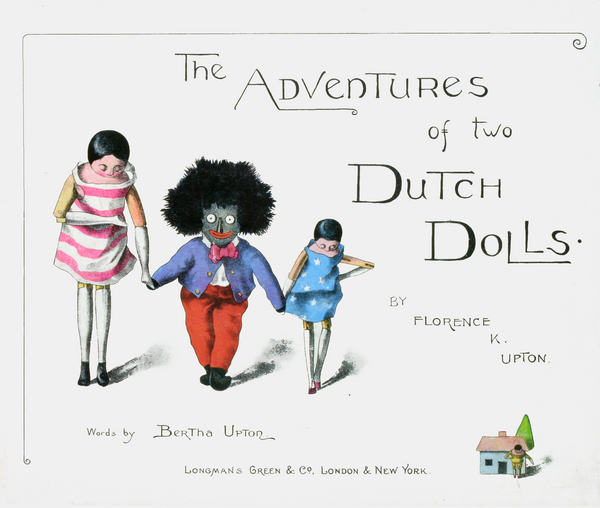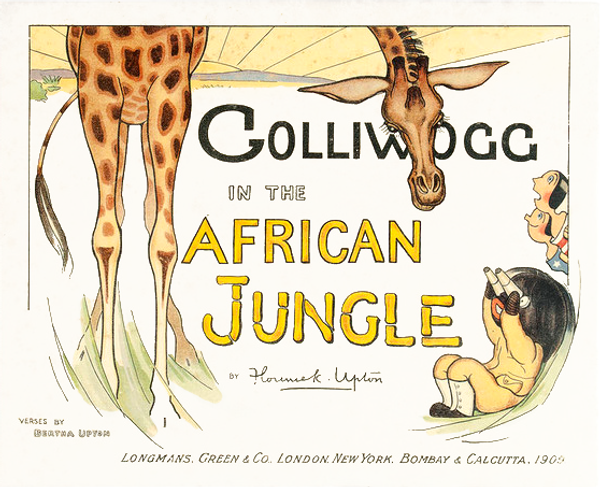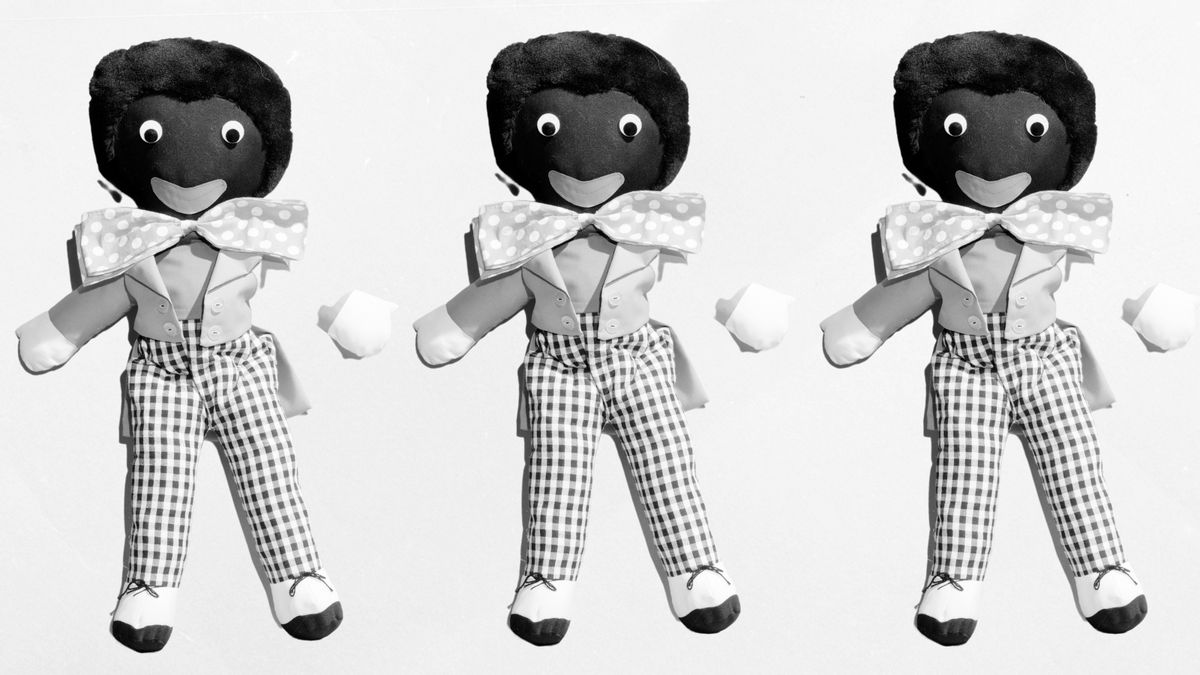If you ever read British author Enid Blyton's widely popular children's books, you'll likely encounter a character known as a "golliwog." Depicted in illustrations with black faces, frizzy hair, thick red lips, and white teeth, these figures are widely considered to be racist caricatures of Black people.
As a toy doll and a character in books and other media, the golliwog (spelled "golliwogg" originally, and also known as "gollywog" or "golly" for short) had its heyday in the late 1800s and 1900s. Since then, it lost its popularity due to people growing aware of its history.
However, the golliwog made headlines in April 2023, generating controversy in the United Kingdom and beyond, when Essex police investigated reports of a hate crime at a pub where multiple golliwog dolls were displayed. After police confiscated the dolls, the woman who owns the property replaced them with new ones, arguing they were not racist.
"I'm getting a notice printed saying, 'We've got gollies on display, if you find this offensive please don't come in'. If they don't like them, they can walk out the door," she said to The Guardian.
Below, in an attempt to answer the question of why some people believe the golliwog to be racist, Snopes lays out what is known about the golliwog's origin story based on museum records and other reputable sources, as well as addresses a viral meme that claims to trace the etymological roots of the word "golliwog" to colonial Egypt.
"The Adventures of Two Dutch Dolls" by the Uptons
Most historical experts believe that the idea of a golliwog came from a late 19th-century storybook by Bertha and Florence Upton, a mother-daughter duo. Merriam-Webster referred to the golliwog as "a type of black rag doll with exaggerated features and colorful clothing that was formerly popular as a children's toy in Britain and Australia." The dictionary said its first known use was in 1895, when the Uptons published the children's fiction book, "The Adventures of Two Dutch Dolls," in which the term was used to describe an animated doll.

Cover of "The Adventures of Two Dutch Dolls" by Bertha and Florence Kate Upton. (Bertha and Florence Kate Upton/Wikimedia Commons)
The Victoria and Albert Museum in the U.K. echoed this origin story, stating, "Florence, the illustrator of the stories, based the golliwog on a doll she had acquired in the US in the 1880s."
In other words, according to the museum, the Uptons were among the first people (if not the first) to be documented using the term "golliwog" for a doll-like character, which they had created based on an actual doll from the U.S. That type of doll, the Victoria and Albert Museum said, was influenced by the Blackface performance tradition — that is, the racist practice of white people using exaggerated makeup and costumes to portray Black characters in scenes that make Blackness the butt of the joke — and its popularity waned by the 1970s as many people began to feel it promoted racial stereotypes.
At Michigan's Ferris State University, the Jim Crow Museum of Racist Memorabilia described the golliwog as "the least known of the major anti-black caricatures in the United States," and a caricature of American Blackface minstrels, which are white performers who use blackened faces to act out stereotypes about Black people. That museum described the Uptons' "The Adventures of Two Dutch Dolls" like this:
The book's main characters were two Dutch dolls, Peg and Sarah Jane, and the Golliwogg. The story begins with Peg and Sara Jane, on the loose in a toy shop, encountering 'a horrid sight, the blackest gnome.' The little black 'gnome' wore bright red trousers, a red bow tie on a high collared white shirt, and a blue swallow-tailed coat. He was a caricature of American black faced minstrels -- in effect, the caricature of a caricature. She named him Golliwogg.
This character, the golliwog, became immensely popular in England, and it traveled with his fictional friends, the Dutch Dolls, to places like Africa and the North Pole in the Uptons' subsequent books.

(Bertha and Florence Kate Upton/Wikimedia Commons)
For its second printing, the first book with the golliwog character was renamed to "The Adventures of Two Dutch Dolls and a Golliwogg." The golliwog also got first billing on the covers of Uptons' books like a 1906 copy of "The Golliwogg's Desert Island."
However, the Jim Crow Museum described the Uptons' version of the golliwog as relatively less racially insensitive compared to later depictions by authors like Enid Blyton. In her books, such as "Here Comes Noddy Again," golliwogs were portrayed as villainous, rude, and mischievous.
In addition to those literary pieces about the fictional character, toy makers in the first half of the 20th century helped the golliwog go mainstream by manufacturing physical dolls with Black features and exaggerated facial features.
About That Viral Meme Alleging Colonial Egyptian Roots
The etymological origins of the word "golliwog" have been debated for years. We have received a number of queries from readers asking us to confirm whether the term was connected to the word "wogs," which has a range of reported meanings and historic uses, including being used as an English slur for dark-skinned people during World War II.
The readers' messages contained social media posts alleging a connection between "golliwog" and "wogs," a word used by the British in Egypt at the end of the 19th century. According to the posts, the term "wog" was an acronym for "workers on government service" and was used to refer to Egyptians working for the British government at that time. They also claimed that Egyptians played with black stuffed dolls — apparently unrelated to similar looking dolls that were popular among Americans around the same time (as we described above) — that British soldiers purchased and took back to England.
It's unclear how, or based on what sources, the authors of the social media posts came to these conclusions. However, based on our research, there is no evidence to confirm a concrete link between the golliwog character displayed via dolls and children's books and the alleged use of the word "wogs" by the British in Egypt.
Rather, there are many unknowns about the two words' beginnings, resulting in competing notions about their possible connection, including the idea that "wog" was actually the offspring of "golliwog" — not the other way around.
Historian James Whidden, author of the book "Monarchy and Modernity in Egypt: Politics, Islam and Neo-colonialism Between the Wars," told us via email if there is evidence to substantiate the social media posts' claims about colonial Egypt, it is important to note that the "workers on government service" tag was a racist insult at the time:
British colonies were always based on a version of the caste system, whether the white/black of the American colonies, or the similar arrangements in India and Egypt. The Egyptian workers in the British administration of colonial Egypt held subordinate posts (British personnel were paid more and held the higher positions) and wogs was meant to remind Egyptians of their subordinate status by their British superiors. [...] Racist language intensified during both World Wars as there were large numbers of British military personnel in Egypt, underlining the caste-like system, and no doubt that popularized the term in Britain.
He added that the term "wogs" was initially used to describe educated Egyptians who "worked in close company with British officers," also known as "the effendis (scribes).
According to The Guardian and "Cairo: Living Past, Living Future," an educational tool housed at the University of Texas at Austin, "wog" has also reportedly been used as an acronym for "worthy oriental gentleman," or "westernised (or wily) oriental gentlemen," both of which were intended to be insults. Whidden said terms like "wily oriental gentleman" were later inventions, while the early use of the term "wog" was for "workers on government service."
However, Oxford University Press' "Word Myths: Debunking Linguistic Urban Legends" by David Wilton said messages that describe the origin of "wogs" to be "workers on government service" are wrong. He called that notion a "fanciful, but untrue tale."
Wilton also connected the term to golliwogs, saying, "while the origin of wog is not known with absolute certainty, most etymologists agree that it is likely a clipping of golliwog, a black-faced doll with frizzy hair." He then attributed the word golliwog to the Uptons, and added that, by 1907, it was in "generic use" for anything Asian.
"Wog" as an English Slur
Like other sources, Whidden, the historian with whom we connected, did not definitively prove a connection between the words "wogs" and "golliwog," regardless of Egyptians' involvement or not. However, he said he would not be surprised if the latter term was a version of the former, "which came to signify people of color more generally in British discourse."
The Online Etymology Dictionary (OED) indeed linked "wog" to "golliwog." (The entry did not say anything about Egypt.) The OED stated that "wog" was possibly shortened from "golliwog," and that the latter first appeared in 1895 (the year that the Uptons published "The Adventures of Two Dutch Dolls"), while "wog" was first used in 1920. The entry read:
wog (n.)
c. 1920, "a lower-class babu shipping clerk" [Partridge]; but popularized in World War II British armed forces slang for "Arab," also "native of India" (especially as a servant or laborer), roughly equivalent to American gook; possibly shortened from golliwog. Many acronym origins have been proposed, but none has been found satisfactory. Related: Wogland.
Reiterating that timeline, the Jim Crow Museum said that while the golliwog was commonly associated with the word "wog," the latter term came later as a racial epithet comparable to the N-word:
Apparently derived from the word Golliwog, wog is an English slur against dark-skinned people, especially Middle or Far East foreigners. During World War II the word wog was used by the British Army in North Africa, mainly as a slur against dark-skinned Arabs. In the 1960s the Argyll and Sutherland Highlanders, one of the most noted regiments in the British Army, wore a Robertson's golly brooch for each Arab they had killed ("And There's Even More: Golly", n.d.) After the war, wog became a more general slur against brown-skinned people. As a racial epithet, it is comparable to nigger or spic, though its usage extends beyond any single ethnic group. Dark-skinned people in England, Germany, and Australia are derisively called wogs. In the year 2000, a British police officer was fired for referring to an Asian colleague as a wog ("British policeman", 2000). The association of wog with racial minorities is also seen with the word wog-box, which is slang for a large portable music box, the European counterpart of the ghetto blaster. The wog-box is also called a "Third World briefcase" (Green, 1984, p. 309).
In sum, most experts and historic sources we have consulted stated that the term "wog" became common use after the emergence of the golliwog character and doll. As such, the claims in the tweets and Facebook post that argued golliwogs came from "workers on government service" were likely incorrect given that "wogs" became popular when golliwogs were already in the British public consciousness.
Even if "golliwogs" and "wogs" are etymologically linked, that fact would not necessarily discredit the notion that the dolls promote racial stereotypes. We have reached out to a number of experts to complete this report and will update it if we get more information.
